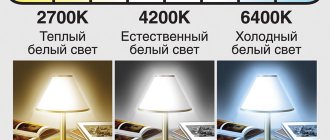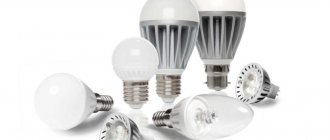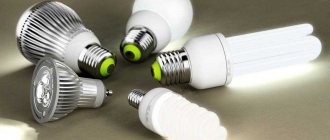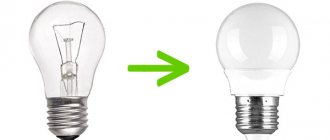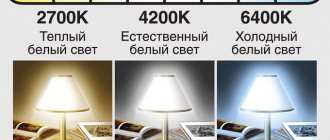How to calculate lamp power?
In order to calculate the lighting power depending on the area, it is advisable to use the formula: P = pS/N, Where, P is the power of the lighting device, W/m.
Interesting materials:
Where is the command line in 10? Where is the Szv td report in 1s Zup? Where in Africa is Portuguese spoken? Where is it coldest in Antarctica? Where can you swim in April? Where is it hot in April and you can swim? Where are finished products shown on the balance sheet? Where is the net asset value on the balance sheet? Where is the authorized capital indicated on the balance sheet? Where are dividends shown on the balance sheet?
Manufacturers' tricks
When replacing all the light bulbs in your home with LEDs, it is important to carefully choose the manufacturer.
In recent years, the production of light bulbs has increased, and some characteristics have also changed. For example, in 2014, a 10-watt lamp produced a luminous flux of 1000 lm . Products from 2012-2013 have indicators of no more than 700-800 . Manufacturers prefer not to mention such nuances. You should choose those with a higher flow value (indicated on the packaging, measured in Lm).
The service life marked on the factory boxes is overestimated. In addition to the service period, overestimated luminous flux values . For example, one manufacturer indicates 8 W and 650 Lm, and another – 8 W 1000 Lm. In the second case, the numbers are exaggerated.
Another situation is undercharacterization . This means that they can indicate a power of 5 W, but in fact the light bulb is 7 or 8 W. Electricity consumption is high, and efficiency is much lower. You can avoid such situations if you purchase light bulbs at points of sale that have already been verified . You can read reviews on the Internet, check with friends.
LED lamps: power characteristics, other indicators
Energy-saving LED has a number of other important advantages, in addition to lower power consumption. To understand them in more detail, let’s take, for example, a 9W LED light bulb (which corresponds to a regular 60W one) and compare their basic parameters. The main ones are:
- Current strength: 0.072 A and 0.27 A, respectively.
- Luminous flux (brightness): 454.2 lm and 612 lm.
- Light output efficiency: 53.4 Lm/W and 10.3 Lm/W.
- Operating temperature: 70 degrees Celsius and 180 degrees Celsius.
- Color temperature: 2700-6000 K and 2800 K, respectively.
- Service life: 30,000 hours and 1,000 hours.
Lighting of this amount of watts is suitable, for example, for a living room. High power devices are not needed here; one LED source is enough instead of several incandescent lamps. Based on the characteristics proposed above, the advantage of a 9W energy-saving lamp over a conventional 60W lamp is obvious. Significant savings in electrical energy, bright white lighting, long service life. Isn't this what you're aiming for when choosing an LED?
Third step: take into account the characteristics of the room to calculate brightness
When the ceilings are high, and you do not lower the chandelier to a level of 2.5–2.7 m, then to obtain a more accurate result, multiply the final calculations by the coefficient from the table.
| Ceiling height | Additional coefficient |
| 2.5 - 2.7 m | 1 |
| 2.7 - 3 m | 1,2 |
| 3 - 3.5 m | 1,5 |
| 3.5 - 4.5 m | 2 |
Also remember that dark colors and matte textures of surfaces (walls, furniture) absorb light, which is why brighter light bulbs are required.
Large windows and white glossy surfaces will brighten the room.
If you have a large room - for example, 20 m² or more, and you find a chandelier that should illuminate 30 m², this does not mean that it will be enough. Why? Because we will get a bright spot in the center, but the edges of the room will remain dim.
Therefore, our recommendation is to expect that one chandelier illuminates 10–12 m². For other areas, additional sources are needed to help illuminate the room evenly - another chandelier, spotlights or pendant lamps, sconces, floor lamps.
If there is no desire or technical ability to use additional light sources, then we offer a solution that allows you to make the light uniform throughout the room by distributing the sources throughout the ceiling. The options are: spider chandeliers, track systems, spotlights. There is a nuance with spotlights. If they have a diffused flood light (usually LED), then the principle of light uniformity will work. If the spotlight is placed under light bulbs, the light will not be scattered throughout the room, but will illuminate only small areas underneath, which will make the lighting of the room slightly dappled.
Conclusion: if we consider ordinary chandeliers, then take them for 10–12 m², and if larger, add additional light sources.
Luminous flux measurement
When purchasing, you need to pay attention to the luminous flux of the lamp, which is measured in lumens. It can be found on the packaging as the designation lm or lm. It is worth noting that each room has a different luminous flux.
It is worth noting that LEDs have a high luminous flux. To roughly understand how much area can be illuminated by 1 LED light bulb, you need to determine the number of lumens per square meter.
If the area of the room is 3 square meters, then there should be 300 lumens per square meter. Therefore, it is necessary to purchase an LED with 900 lumens efficiency. And the ratio of power and luminous flux of lamps is given in the table.
Lumens, as an indicator, characterize only the luminous flux. The illumination of a room must be measured using another indicator - lux.
The importance of room illumination is very high when designing the arrangement of light sources. So, every square meter of the room will be illuminated with maximum brightness.
Thus, if an LED emits 900 lumens of light over an area of 3 square meters, then the total illumination of the room will be 300 lux.
Comparison: incandescent, halogen, fluorescent and LED:
In addition, a comparison of lamps of different types is well described in the article “Comparison of lamps...”
When choosing lighting, many are faced with the problem of choice: what is better - non-expensive incandescent lamps or LED lamps at a higher price? To determine which purchase will be more profitable, you need to familiarize yourself with all the characteristics of each variety.
Basic indicators
We have compared LED lamps and incandescent lamps to clearly demonstrate the main characteristics in action:
- First of all, you need to remember that LED lamps do not flicker. Therefore, their use does not harm human vision;
- Also, no harmful substances are used in their production;
- In addition, LEDs are a non-separable structure that is resistant to strong vibrations and shocks, unlike incandescent lamps;
- LEDs have an average lifespan of 50,000 hours, while incandescent bulbs have an average lifespan of 1,000.
- The design of LEDs does not contain filaments, which contribute to overheating. They often have efficient cooling systems that allow the device to cool down faster.
Other parameters are approximately the same as incandescent lamps. For example, LEDs do not emit mercury vapor, which is not harmful to the environment.
Table for calculating lighting according to SNiP and SanPiN
We determine the required amount of light in the rooms for a comfortable life
Each room requires its own level of illumination. It is traditionally measured in lux and denoted as lx - this indicator is a unit of luminous flux per 1 m² of area.
The tables of SNiP No. 23-05-95 and SanPiN No. 2.21/2.1.1.1278-03 indicate the minimum illumination levels that are recommended for residential and non-residential premises.
| Room | Standard luminous flux per 1 m² according to SanPiN (lx) | Standard luminous flux per 1 m² according to SNiP (lx) | Our comments and recommendations |
| Living rooms, living rooms and bedrooms | 150 | 150 | This light is enough for everyday life. For reading, needlework, selecting clothes, and thorough cleaning, you will need at least 350 lx of general light or additional lighting for individual and work areas. |
| Kitchens and kitchen-dining rooms | 150 | 150 | This light is only enough for moving around the kitchen and eating. For cooking, additional illumination of the work area is required. We recommend 400 lx. |
| Children's room | 200 | 200 | To illuminate the work area (lessons, games, activities), additional lighting is required (at least 400 lx). |
| Bathrooms, showers, toilets and combined toilets | 50 | 50 | For general lighting, we recommend at least 200 lx, taking into account the fact that we use additional lighting above sinks, bathtubs and showers. We advise you to at least add additional lighting to the mirrors. Even mediocre cleaning requires more lighting than 50 lx, not to mention cosmetic procedures and high-quality cleaning of tiles and plumbing. |
| Residential rooms of dormitories | 150 | — | The recommendations are similar to those we gave for living rooms, living rooms and bedrooms. |
| Offices and libraries | 300 | 300 | This is quite bright lighting - it may be enough for work, and certainly enough to not get lost among the bookshelves. But for illuminating work with documents on tables, we would recommend 400 lx. |
| Indoor corridors and halls | 50 | 50-75 | If there are no mirrors in the corridors, and they are used only for movement, then such lighting will be sufficient. |
| Storerooms and utility rooms | 30 | 50 | If you want to read inscriptions and labels on cans, for example, then you will have to use flashlights. At 150 lx you can read the label without tripping. If you store large items in your pantries, the recommended brightness level will be sufficient. |
| Dressing rooms | 75 | 75 | A brighter light is needed - as for work (300 lx), otherwise stains, wrinkles and shades of fabrics are difficult to see. |
| Sauna, Changing rooms | 100 | 100 | In the sauna we recommend using adjustable light. For example, from 30 to 300 lx. For cleaning it is better to use a bright light of 300 lx, and for relaxation it should be possible to use the dimmest light (30 lx). For locker rooms, our recommendations are the same as for bathrooms. |
| Pool | 100 | 100 | If we are talking specifically about the room where the swimming bowls themselves are located, then we agree with the recommendations. For both decorative and functional purposes, using lighting inside the bowl itself is beautiful, and you can find rings and other lost items. |
| Gym | 150 | — | As a rule, in the gym, athletes look at themselves in mirrors, so it is better when the light is bright, for example, 300 lx. And if yoga and other spiritual practices are held in the hall, then it should be possible to create darkness, for example, 30-50 lx. |
| Billiard room | 300 | — | We agree. |
| Concierge room | 150 | — | Think about the health of the concierge - at least add additional lighting to the work area. |
| Stairs | 20 | 20 | It's dusk. Whether to highlight or not is a matter of taste. |
| Floor-to-floor non-apartment corridors | 20 | 0 | Same as stairs. |
| Strollers, bicycles | 20 | — | Same as stairs. |
| Heating points, pumping rooms, electrical switchboards, elevator machine rooms and ventilation chambers | 20 | — | To work, you will need additional bright light - 300 lx. |
| Main passages of technical floors, undergrounds, cellars, attics | 20 | — | Same as stairs. |
| Elevator shafts | 5 | — | |
| Archive | — | 75 | Clearly not enough for reading. Check out our comments for libraries. |
| Office where drawing work is carried out | — | 500 | Good, bright lighting. |
| Conference hall, meeting room | — | 200 | We recommend 300 lx. |
| Escalator, stairs | — | 50-100 |
Errors in calculations
During renovation work, the plans of the owners of the premises often include replacing conventional incandescent lamps with LED lamps, after which the illumination level may decrease several times.
The reason for this can be a huge number of factors, which include:
- Use of wallpaper, laminate, linoleum in dark shades;
- Incorrect determination of LED color temperature;
- Installation of a stretch ceiling with a matte effect.
Therefore, when determining illumination, it is necessary to take into account the coefficients of the main surfaces of the room - the ceiling, walls and floor:
- 70% – white;
- 50% – light color;
- 30% – gray color;
- 10% – dark color;
- 0% – black color.
To do this, calculate the overall reflectance:
· General K.O.= K.O. ceiling+K.O.walls+K.O.floor)/3.
Once the result has been obtained, it must be multiplied by the previously calculated luminous flux.
